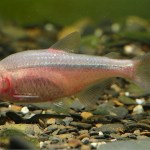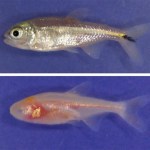eye
Image from Wikimedia Commons
Researchers from La Trobe University and Max Planck Institute for Ornithology recorded young crocodiles and found that while the animals typically sleep with both eyes closed, in the morning hours they will sometimes open one eye periodically. If they placed another crocodile in the tank or stood nearby however, the animal would open one eye and look at the newcomer.
It was noted in the article that certain birds and aquatic mammals will likewise sleep with one eye open, with only half their brain staying awake. This is known as…
Image of eyeless Mexican tetra fish from www.seriouslyfish.com by H-J Chen.
The metabolism of most animals follows a circadian rhythm that differs between the day and night. Mexican cavefish living in constant darkness, lost this circadian rhythm some time ago. In a newly published study in PLOS ONE, researchers compared the metabolic rate of both cave- and surface-dwelling Mexican tetra fish (Astyanax mexicanus). They hypothesized that since the fish living in each location naturally experience differences in food, predation as well as exposure to daily light fluctuations, they might also…
Image from LiveScience. Credit: Richard Borowsky
Heat shock protein 90 (HSP90) helps keep proteins in the body folded properly and is thought to compensate for variations that occur in proteins over time. In a study published in Science magazine, Dr. Nicolas Rohner and colleagues showed that stress can affect the ability for HSP90 to do its job thereby unmasking these alternative versions of proteins which may lead to adaptation in some cases.
The theory was tested in fish called Mexican tetra (above), some of which adapted to life in caves leading to eventual loss of, or diminished,…
Image from U Penn.
I came across this really interesting press release from the University of Pennsylvania that I just had to share.
Despite having a close relationship with dogs for thousands of years, we are still making new discoveries about our canine friends. Drs. William Beltran (School of Veterinary Medicine), Artur Cideciyan (Perelman School of Medicine), and colleagues teamed up to study canine eyes in an effort to improve treatments for humans with retinal diseases.
Dr. Beltran was quoted as saying “It’s incredible that in 2014 we can still make an anatomical discovery in a…
In the forests of South America lives the unusual but aptly named owl monkey, or douroucouli. You could probably guess by looking at its large round eyes that it's nocturnal, and indeed, it is the only monkey to be mostly active at night. But its eyes have many adaptations for such a lifestyle, beyond a large size.
The owl monkey's retinas are 50% larger than those of a day-living monkey of similar size, like the brown capuchin. The proportions of different cells in their retina are also different. Owl monkeys have relatively few cone cells, which are responsible for colour vision and fewer…
Nocturnal animals face an obvious challenge: collecting enough light to see clearly in the dark. We know about many of their tricks. They have bigger eyes and wider pupils. They have a reflective layer behind their retina called the tapetum, which reflects any light that passes through back onto it. Their retinas are loaded with rod cells, which are more light-sensitive than the cone cells that allow for colour vision.
But they also have another, far less obvious adaptation - their rod cells pack their DNA in a special way that turns the nucleus of each cell into a light-collecting lens.…
You've probably heard about the man with the eyeball camera. Here's the most detailed (and sometimes graphic) video I've yet seen about documentary filmmaker Rob Spence (aka Eyeborg), who is working on getting his prosthetic eye replaced with a wireless eye socket camera:
I first encountered Spence in this writeup at Wired last fall. According to the new video, they've hit a few snags since then, but for some reason Spence is all over the news right now. And it's a safe bet he'll continue to be, if he becomes the first cyborg reporter with a bionic eyecamera!
More: a briefer AP video on…
Up until now, our route into the theory of evolution by natural selection has been all downhill. One thing has led effortlessly to another, with Darwin giving the occasional nudge to steer things in the right direction. Not any more. If it's human interest you're after -- doubt, sweat, anxiety -- then chapter 6 of the Origin, 'Difficulties on Theory', is the one you've been waiting for.
I obviously wasn't going to admit it, but after chapters 4 and 5, I was beginning to fear that we'd peaked with the struggle of chapter 3. But this chapter is full of gems, both in the science, and in the…
In the twilit waters of the deep ocean, beneath about 1000m of water, swims the brownsnout spookfish (Dolichopteryx longipes). Like many other deep-sea fish, the spookfish is adapted to make the most of what little light penetrates to these depths, but it does so with some of the strangest eyes in the animal kingdom.
For a start, each eye is split into two connected parts, so the animal looks like it actually has four. One half points upwards and gives the spookfish a view of the ocean above. The other points downwards into the abyss below and it's this half that makes the spookfish unique.…


